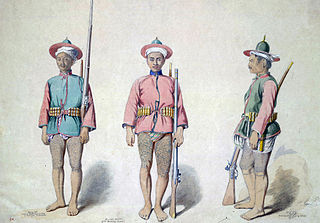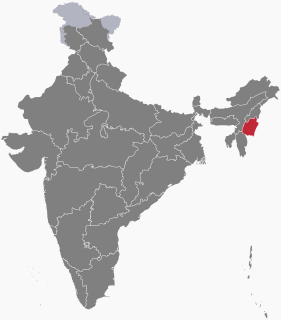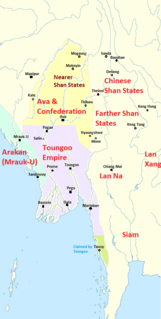 W
WThe First Anglo-Burmese War, also known as the First Burma War, was the first of three wars fought between the British and Burmese empires in the 19th century. The war, which began primarily over the control of Northeastern India, ended in a decisive British victory, giving the British total control of Assam, Manipur, Cachar and Jaintia as well as Arakan Province and Tenasserim. The Burmese submitted to a British demand to pay an indemnity of one million pounds sterling, and sign a commercial treaty.
 W
WThe Third Anglo-Burmese War, also known as the Third Burma War, was a conflict that took place during 7–29 November 1885, with sporadic resistance and insurgency continuing into 1887. It was the final of three wars fought in the 19th century between the Burmese and the British. The war saw the loss of sovereignty of an independent Burma under the Konbaung dynasty, whose rule had already been reduced to the territory known as Upper Burma, the region of Lower Burma having been annexed by the British in 1853, as a result of the Second Anglo-Burmese War.
 W
WThe Burma Independence Army (BIA) was a collaborationist and revolutionary army that fought for the end of British rule in Burma by assisting the Japanese in their conquest of the country in 1942 during World War II. It was the first post-colonial army in Burmese history. The BIA was formed from group known as the Thirty Comrades under the auspices of the Imperial Japanese Army after training the Burmese nationalists in 1941. The BIA's attempts at establishing a government during the invasion led to it being dissolved by the Japanese and the smaller Burma Defence Army (BDA) formed in its place. As Japan guided Burma towards nominal independence, the BDA was expanded into the Burma National Army (BNA) of the State of Burma, a puppet state under Ba Maw, in 1943.
 W
WThe Burmese–Siamese War (1547–1549) was the first war fought between the Toungoo Dynasty of Burma and the Ayutthaya Kingdom of Siam, and the first of the Burmese–Siamese wars that would continue until the middle of the 19th century. The war is notable for the introduction of early modern warfare to the region. It is also notable in Thai history for the death in battle of Siamese Queen Suriyothai on her war elephant; the conflict is often referred to in Thailand as the War that Led to the Loss of Queen Suriyothai (สงครามคราวเสียสมเด็จพระสุริโยไท).
 W
WThe Burmese-Siamese War of 1563-1564, also known as the War over the White Elephants, was a war between the Toungoo Dynasty of Burma and the Ayutthaya Kingdom of Siam. It was the second of twenty wars fought between the Burmese and Siamese that lasted well into the 19th century. The cause of the war was an attempt by the Toungoo king Bayinnaung to force the Ayutthaya kingdom into submission under his rule, as part of his campaign that later created the largest empire ever to exist in Southeast Asia. 13 years into Bayinnaung's reign, his second attempt at invasion of Siam and first as king succeeded after an extensive siege of the city of Ayutthaya. Siam became a vassal of the Toungoo Dynasty, this status lasting until a 1568 revolt by Ayutthaya resulting in a short-lived independence.
 W
WThe Burmese–Siamese War (1568–1569) was a military conflict fought between the Kingdom of Ayutthaya (Siam) and the Kingdom of Burma. The war began in 1568 when Ayutthaya unsuccessfully attacked Phitsanulok, a Burmese vassal state. The event was followed by a Burmese intervention which resulted in the 2 August 1569 defeat of Ayutthaya, which became a Burmese vassal state. Burma then moved towards Lan Xang, occupying the country for a short period of time until retreating in 1570.
 W
WThe Burmese–Siamese War (1593–1600) was the war fought between the Toungoo Dynasty of Burma and the Ayutthaya Kingdom of Siam. The war was the culmination of Siam's move towards independence following subjugation after the Burmese–Siamese War (1584–1593). The war ended with a victory by Siam, which seized the cities of Tavoy and Tenasserim, and laid siege to two major cities of the Toungoo Dynasty.
 W
WThe Burmese–Siamese War (1759–1760) was the first military conflict between the Konbaung Dynasty of Burma (Myanmar) and the Ban Phlu Luang Dynasty of Siam (Thailand). It reignited the centuries-long warfare between the two states that would go on for another century. The Burmese were "on the brink of victory" when they suddenly withdrew from their siege of Ayutthaya because their king Alaungpaya had fallen ill. He died three weeks later, ending the war.
 W
WThe Burmese–Siamese War (1765–1767) was the second military conflict between the Konbaung dynasty of Burma (Myanmar) and the Ban Phlu Luang Dynasty of Siam (Thailand), and the war that ended the four-century-old Siamese kingdom. Nonetheless, the Burmese were soon forced to give up their hard-won gains when the Chinese invasions of their homeland forced a complete withdrawal by the end of 1767. A new Siamese dynasty, to which the current Thai monarchy traces its origins, emerged to reunify Siam by 1770.
 W
WThe Burmese–Siamese War (1785–1786), known as the Nine Armies' Wars in Siamese history because the Burmese came in nine armies, was fought between the Konbaung dynasty of Burma and the Chakri dynasty of resurgent Siam (Thailand).
 W
WThe Burmese–Siamese War of 1849–1855 was a war between the Burmese Konbaung Dynasty and the Siamese Rattanakosin Kingdom, the last of twenty wars fought between the Burmese and the Siamese between the 16th and 19th centuries. The war was the result of attempts by the Siamese to recapture much of the land they had lost to the Burmese in previous wars, as well as make reality their claims in the trans-Salween region of Myanmar that had been contested for hundreds of years. After heavy fighting, the Burmese drove the Siamese out of Shan territory, ending realistic Siamese hopes of reclaiming the territory.
 W
WThe communist insurgency in Myanmar was a conflict fought primarily by the Communist Party of Burma and the Communist Party (Burma) from 1948 to 1988. The conflict ended when the armed wing of the Communist Party of Burma disbanded following the Fall of Communism and the ousting of the Burmese socialist dictatorship.
 W
WThe Forty Years' War was a military conflict fought between the Burmese-speaking Kingdom of Ava and the Mon-speaking Kingdom of Hanthawaddy Pegu. The war was fought during two separate periods: 1385 to 1391, and 1401 to 1424, interrupted by two truces of 1391–1401 and 1403–1408. It was fought primarily in today's Lower Burma and also in Upper Burma, Shan State, and Rakhine State. It ended in a stalemate, preserving the independence of Hanthawaddy, and effectively ending Ava's efforts to rebuild the erstwhile Pagan Kingdom.
 W
WThe Insurgency in Manipur is an ongoing armed conflict between India and a number of separatist rebel groups, taking place in the region of Manipur. The Insurgency in Manipur is part of the wider Insurgency in Northeast India; it combines elements of a national liberation war as well as an ethnic conflict.
 W
WThe Insurgency in Arunachal Pradesh is a part of the larger Northeast India insurgency involving multiple groups trying to separate from or destabilize the province. Because of Arunachal Pradesh's close proximity to the border, many groups are able to use border crossings to promote their terrorist activity. Since Arunachal Pradesh's recapture in the 1962 War, there has been incursions from the Chinese Army in the region further escalating the conflict. The conflict has slowed since the early 2000s due to police arrest of major insurgent leaders. The highly diverse ethnic and religious population of the province has also influenced various groups.
 W
WInsurgency in Northeast India involves multiple armed separatist factions operating in India's northeastern states, which are connected to the rest of India by the Siliguri Corridor, a strip of land as narrow as 14.29 miles (23.00 km) wide. Most factions favour a separate nation while others seek regional autonomy, some groups demand complete independence and others demand religious law.
 W
WThe internal conflict in Myanmar is a series of insurgencies in Myanmar that began shortly after the country, then known as Burma, gained independence from the United Kingdom in 1948. The conflict has largely been ethnic-based, with several ethnic armed groups fighting Myanmar's armed forces, the Tatmadaw, for self-determination. Despite numerous ceasefires and the creation of autonomous self-administered zones in 2008, many groups continue to call for independence, increased autonomy, or the federalisation of the country. The conflict is also the world's longest ongoing civil war, having spanned more than seven decades.
 W
WThe Kachin conflict or Kachin War is one of the multiple conflicts collectively referred to as the internal conflict in Myanmar. Kachin insurgents have been fighting government soldiers since 1961, with only one ceasefire being brokered between them, which lasted for 17 years from 1994 to 2011.
 W
WThe Karen conflict is an armed conflict in Kayin State, Myanmar. The conflict has been described as one of the world's "longest running civil wars".
 W
WThe Konbaung–Hanthawaddy War was the war fought between the Konbaung Dynasty and the Restored Hanthawaddy Kingdom of Burma (Myanmar) from 1752 to 1757. The war was the last of several wars between the Burmese-speaking north and the Mon-speaking south that ended the Mon people's centuries-long dominance of the south.
 W
WThis is a list of campaigns of Kublai Khan, founder of the Yuan dynasty.
 W
WThe first Mongol invasions of Burma were a series of military conflicts between Kublai Khan's Yuan dynasty, division of the Mongol Empire, and the Pagan Empire that took place between 1277 and 1287. The invasions toppled the 250-year-old Pagan Empire, and the Mongol army seized Pagan territories in present-day Dehong, Yunnan and northern Burma to Tagaung. The invasions ushered in 250 years of political fragmentation in Burma and the rise of ethnic Tai-Shan states throughout mainland Southeast Asia.
 W
WThe Rohingya conflict is an ongoing conflict in the northern part of Myanmar's Rakhine State, characterised by sectarian violence between the Rohingya Muslim and Rakhine Buddhist communities, a military crackdown on Rohingya civilians by Myanmar's security forces, and militant attacks by Rohingya insurgents in Buthidaung, Maungdaw, and Rathedaung Townships, which border Bangladesh.
 W
WThe Sino-Burmese War, also known as the Qing invasions of Burma or the Myanmar campaign of the Qing dynasty, was a war fought between the Qing dynasty of China and the Konbaung dynasty of Burma (Myanmar). China under the Qianlong Emperor launched four invasions of Burma between 1765 and 1769, which were considered as one of his Ten Great Campaigns. Nonetheless, the war, which claimed the lives of over 70,000 Chinese soldiers and four commanders, is sometimes described as "the most disastrous frontier war that the Qing dynasty had ever waged", and one that "assured Burmese independence". Burma's successful defense laid the foundation for the present-day boundary between the two countries.
 W
WThe Toungoo–Ava War (1538–1545) was a military conflict that took place in present-day Lower and Central Burma (Myanmar) between the Toungoo Dynasty, and the Ava-led Confederation of Shan States, Hanthawaddy Pegu, and Arakan (Mrauk-U). Toungoo's decisive victory gave the upstart kingdom control of all of central Burma, and cemented its emergence as the largest polity in Burma since the fall of Pagan Empire in 1287.
 W
WThe Toungoo–Hanthawaddy War (1534–1541) was a military conflict between the Toungoo Kingdom, and the Hanthawaddy Kingdom and its allies the Prome Kingdom and the Confederation of Shan States that took place in present-day Lower Burma (Myanmar) between 1534 and 1541. In a series of improbable events, the upstart Burmese-speaking kingdom defeated Mon-speaking Hanthawaddy, the most prosperous and powerful of all post-Pagan kingdoms before the war. In the following years, Toungoo used the newly acquired kingdom's wealth and manpower to reunify the various petty states that had existed since the fall of Pagan Empire in 1287.
 W
WThe Taungoo–Mrauk-U War (1545–1547) was a military conflict that took place in Arakan from 1545 to 1547 between the Taungoo Dynasty and the Kingdom of Mrauk U. The western kingdom successfully fended off the Taungoo invasions, and kept its independence. The war had a deterrence effect: Mrauk U would not see another Taungoo invasion until 1580.
 W
WWorld War II, also known as the Second World War, was a global war that lasted from 1939 to 1945. It involved the vast majority of the world's countries—including all the great powers—forming two opposing military alliances: the Allies and the Axis. In a state of total war, directly involving more than 100 million people from more than 30 countries, the major participants threw their entire economic, industrial, and scientific capabilities behind the war effort, blurring the distinction between civilian and military resources. World War II was the deadliest conflict in human history, marked by 70 to 85 million fatalities. Tens of millions of people died due to genocides, premeditated death from starvation, massacres, and disease. Aircraft played a major role in the conflict, including in the use of strategic bombing of population centres, and the only uses of nuclear weapons in war.